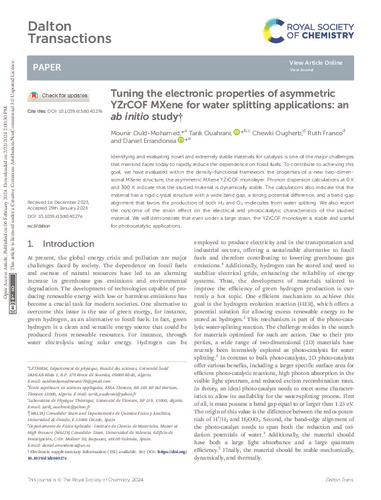Tuning the electronic properties of asymmetric YZrCOF MXene for water splitting applications: an ab initio study
Publication date:
Editorial:
Royal Society of Chemistry
Publisher version:
Citación:
Descripción física:
Abstract:
Identifying and evaluating novel and extremely stable materials for catalysis is one of the major challenges that mankind faces today to rapidly reduce the dependence on fossil fuels. To contribute to achieving this goal, we have evaluated within the density-functional framework the properties of a new two-dimensional MXene structure, the asymmetric MXene YZrCOF monolayer. Phonon dispersion calculations at 0 K and 300 K indicate that the studied material is dynamically stable. The calculations also indicate that the material has a rigid crystal structure with a wide band gap, a strong potential difference, and a band-gap alignment that favors the production of both H2 and O2 molecules from water splitting. We also report the outcome of the strain effect on the electrical and photocatalytic characteristics of the studied material. We will demonstrate that even under a large strain, the YZrCOF monolayer is stable and useful for photocatalytic applications.
Identifying and evaluating novel and extremely stable materials for catalysis is one of the major challenges that mankind faces today to rapidly reduce the dependence on fossil fuels. To contribute to achieving this goal, we have evaluated within the density-functional framework the properties of a new two-dimensional MXene structure, the asymmetric MXene YZrCOF monolayer. Phonon dispersion calculations at 0 K and 300 K indicate that the studied material is dynamically stable. The calculations also indicate that the material has a rigid crystal structure with a wide band gap, a strong potential difference, and a band-gap alignment that favors the production of both H2 and O2 molecules from water splitting. We also report the outcome of the strain effect on the electrical and photocatalytic characteristics of the studied material. We will demonstrate that even under a large strain, the YZrCOF monolayer is stable and useful for photocatalytic applications.
ISSN:
DOI:
Patrocinado por:
D. E. thanks the financial support from the Spanish Ministerio de Ciencia e Innovación (https://doi.org/10.13039/ 501100011033) under Projects PID2019-106383GB-41, PID2022-138076NB-C41, RED2018-102612-T, and RED2022- 134388-T. D. E. also acknowledges the financial support of Generalitat Valenciana, through grants PROMETEO CIPROM/ 2021/075-GREENMAT and MFA/2022/007. This study forms part of the Advanced Materials program and is supported by MCIN with funding from the European Union Next Generation EU (PRTR-C17.I1) and by the Generalitat Valenciana. R. F. acknowledges the financial support from Spanish MCIU under projects 22-PID2021-122585NB-C21, and from Principado de Asturias (FICYT) and FEDER under project AYUD/2021/51036 are gratefully acknowledged. Wethank the MALTA-Consolider supercomputing center for computer facilities.
Collections
- Artículos [37538]
- Investigaciones y Documentos OpenAIRE [8403]
- Química Física y Analítica [639]
Files in this item





